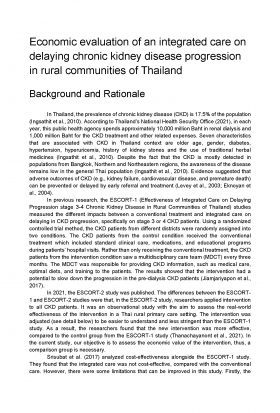This website uses cookies so that we can provide you with the best user experience possible. Cookie information is stored in your browser and performs functions such as recognising you when you return to our website and helping our team to understand which sections of the website you find most interesting and useful.
Economic evaluation of an integrated care on delaying chronic kidney disease progression in rural communities of Thailand
Project Code
66161066HM016L0
Research team
Researchers
Prof. Emeritus Kriang Tungsanga
Co - Researcher
Molly Paffet
Teerawat Thanachayanont
Teerayuth Jiamjariyaporn
Methee Chanpitakkul
Project Details
Start: 1 August 2023
End: 30 April 2024
Project Status
Conducting Research - 48%
Viewer: 1835
Publish date30 August 2023 12:27
Project Summary
In Thailand, the prevalence of chronic kidney disease (CKD) is 17.5% of the population (Ingsathit et al., 2010). According to Thailand’s National Health Security Office (2021), in each year, this public health agency spends approximately 10,000 million Baht in renal dialysis and 1,000 million Baht for the CKD treatment and other related expenses. Seven characteristics that are associated with CKD in Thailand context are older age, gender, diabetes, hypertension, hyperuricemia, history of kidney stones and the use of traditional herbal medicines (Ingsathit et al., 2010). Despite the fact that the CKD is mostly detected in populations from Bangkok, Northern and Northeastern regions, the awareness of the disease remains low in the general Thai population (Ingsathit et al., 2010). Evidence suggested that adverse outcomes of CKD (e.g., kidney failure, cardiovascular disease, and premature death) can be prevented or delayed by early referral and treatment (Levey et al., 2003; Eknoyan et al., 2004).
In previous research, the ESCORT-1 (Effectiveness of Integrated Care on Delaying Progression stage 3-4 Chronic Kidney Disease in Rural Communities of Thailand) studies measured the different impacts between a conventional treatment and integrated care on delaying in CKD progression, specifically on stage 3 or 4 CKD patients. Using a randomized controlled trial method, the CKD patients from different districts were randomly assigned into two conditions. The CKD patients from the control condition received the conventional treatment which included standard clinical care, medications, and educational programs during patients’ hospital visits. Rather than only receiving the conventional treatment, the CKD patients from the intervention condition saw a multidisciplinary care team (MDCT) every three months. The MDCT was responsible for providing CKD information, such as medical care, optimal diets, and training to the patients. The results showed that the intervention had a potential to slow down the progression in the pre-dialysis CKD patients (Jiamjariyapon et al., 2017).
In 2021, the ESCORT-2 study was published. The differences between the ESCORT-1 and ESCORT-2 studies were that, in the ESCORT-2 study, researchers applied intervention to all CKD patients. It was an observational study with the aim to assess the real-world effectiveness of the intervention in a Thai rural primary care setting. The intervention was adjusted (see detail below) to be easier to understand and less stringent than the ESCORT-1 study. As a result, the researchers found that the new intervention was more effective, compared to the control group from the ESCORT-1 study (Thanachayanont et al., 2021). In the current study, our objective is to assess the economic value of the intervention, thus, a comparison group is necessary.
Srisubat et al. (2017) analyzed cost-effectiveness alongside the ESCORT-1 study. They found that the integrated care was not cost-effective, compared with the conventional care. However, there were some limitations that can be improved in this study. Firstly, the sample size of this study was considerably small. In the original ESCORT-1 study, they used 442 participants in total. However, in the study by Srisubat et al. (2017), only 120 patients’ datum were used. In the present study, model-based health economic evaluation will be applied using evidence from various relevant sources including data from both ESCORT-1 and ESCORT-2 to increase the power of the estimation. Secondly, the time length of the ESCORT-1 study was only 2 years. According to Ku et al., (2018), 7.9, 5, 4.2, 0.8 were the numbers of median years that patients spend in stage 3a, 3b, 4, and 5 of CKD, respectively. Therefore, combining the ESCORT-1 and ESCORT-2 studies would provide us benefits since it gives us 5 years of the study in total. In addition, this model-based study allows us to estimate life-time cost and outcome of each policy choice. Thirdly, Srisubat et al. (2017) study did not provide much information about cost-utility of the program intervention. To be more specific, the study only reported the results in terms of incremental cost-per-ESRD patient averted.
Ultimately, the purpose of this paper is to evidence the impact of integrated care intervention on the Thai population. Economic evaluations of the intervention provide information to researchers and policymakers about which intervention is the most suitable in a particular context. This study proposes that the cost-utility analysis is applied with the outcome presented in terms of quality-adjusted life year (QALY) since it is more generalizable than other health economic analyses (e.g., cost-benefit analysis, cost-effectiveness analysis) (Angevine & Berven, 2014). This particular outcome would be beneficial when considering allocative efficiency by comparing the interventions related to kidney care against other public interventions (e.g., cancer screening) (Turner et al., 2021). The next question to be asked is whether the intervention is worth the investment by the public resources and if the intervention could be part of the Universal Healthcare Coverage (UHC)’s benefit package.
Objectives
In the present study, cost-utility analysis will be conducted using societal perspective to evaluate a value for money in terms of incremental cost-per-QALY of the integrated care delivered by the MDCT on delaying CKD progression compared to the conventional treatment in the Thai setting.






 Research Proposal: Economic evaluation of an integrated care on delaying chronic kidney disease progression in rural communities of Thailand
Research Proposal: Economic evaluation of an integrated care on delaying chronic kidney disease progression in rural communities of Thailand
